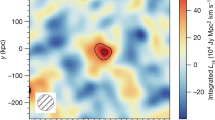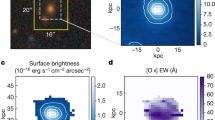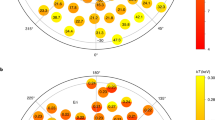Abstract
SEVERAL suggestions have been made to explain the formation of OH in the galaxy, together with possible pumping mechanisms to produce the laser action considered responsible for high anomalous brightness temperatures at least as high as 1010 °K (ref. 1). It is usually assumed that OH is produced in the presence of interstellar particles by sputtering or by a process of chemical exchange on the particles; they also act as the third body and help to conserve energy and momentum. The pumping mechanism suggested by Litvak et al.2 is by continuum ultra-violet radiation which induces selective transitions from the various rotational levels of the (X2II) ground state to the (A2Σ) electronic excited state. By this means an inversion of the population of the ground doublet state is obtained, but on the other hand the energies involved are close to the dissociation energy for OH. The analysis by Cook3 invokes pumping by Lyman-α radiation, but again the energy involved is more than twice the dissociation energy and it is likely that a large percentage of the OH would be dissociated. The two-body process proposed by Symonds4 of forming excited OH from O− and H+ could possibly also provide the pumping mechanism, but unfortunately it requires the liberation of a large amount of energy and it seems unlikely that this process would be effective. A more interesting mechanism has recently come to light with the observation in the laboratory by Spindler et al.5 of the formation of OH in an electronically excited state, as a two-body process involving atomic oxygen and hydrogen, with the emission of radiation in the 3064 Å band. The rate for the reaction has been determined6, and can be expressed by  where I, the intensity of the emission, is assumed equal to the rate of formation of OH molecules, [H] and [O] are the densities of atomic hydrogen and oxygen respectively, and K = 3 × 10−21 molecules cm−3 sec−1 is the rate constant at room temperature. Because this reaction could well be taking place in the cooler parts surrounding individual HII regions it is of interest to assess the possibility that it is also the cause of anomalous OH emission.
where I, the intensity of the emission, is assumed equal to the rate of formation of OH molecules, [H] and [O] are the densities of atomic hydrogen and oxygen respectively, and K = 3 × 10−21 molecules cm−3 sec−1 is the rate constant at room temperature. Because this reaction could well be taking place in the cooler parts surrounding individual HII regions it is of interest to assess the possibility that it is also the cause of anomalous OH emission.
This is a preview of subscription content, access via your institution
Access options
Subscribe to this journal
Receive 51 print issues and online access
$199.00 per year
only $3.90 per issue
Buy this article
- Purchase on Springer Link
- Instant access to full article PDF
Prices may be subject to local taxes which are calculated during checkout
Similar content being viewed by others
References
Davies, R. D., Rowson, B., Booth, R. S., Cooper, A. J., Gent, H., Adgie, R. L., and Crowther, J. H., Nature, 213, 1109 (1967).
Litvak, M. M., McWhorter, A. L., Meeks, M. L., and Zieger, H. J., Phys. Rev. Lett., 17, 821 (1966).
Cook, A. H., Nature, 210, 611 (1966).
Symonds, J. L., Nature, 208, 1195 (1965).
Spindler, G., Ticktin, S., and Schiff, H. I., Nature, 214, 1006 (1967).
Spindler, G., Ticktin, S., and Schiff, H. I., (paper to be presented at meeting of Faraday Society, Toronto, Sept. 1967).
Kaplan, S. A., Interstellar Gas Dynamics (Pergamon Press, Ltd., 1966).
Vandervoort, P. A., Ap. J., 146, 104 (1966).
Dieter, N. H., Weaver, H., and Williams, D. R. W., Sky and Telescope, 31, 132 (1966).
Hughes, V. A., and Butler, R., Nature (preceding article).
Cook, A. H., Nature, 214, 689 (1967).
Author information
Authors and Affiliations
Rights and permissions
About this article
Cite this article
HUGHES, V. Mechanism for Anomalous OH Emission from HII Regions. Nature 215, 942–943 (1967). https://doi.org/10.1038/215942a0
Received:
Revised:
Issue Date:
DOI: https://doi.org/10.1038/215942a0
This article is cited by
-
Formation and Chemical Pumping of OH Molecules
Nature (1968)
-
Protostars as Sources of Anomalous OH Emission
Nature (1968)
Comments
By submitting a comment you agree to abide by our Terms and Community Guidelines. If you find something abusive or that does not comply with our terms or guidelines please flag it as inappropriate.



